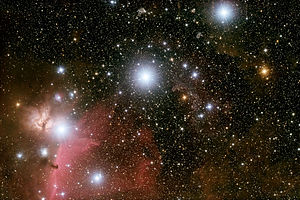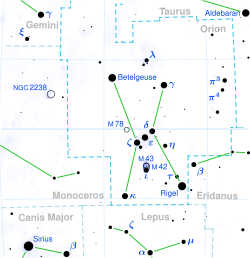Mintaka /ˈmɪntəkə/,[17] designation Delta Orionis (δ Orionis, abbreviated Delta Ori, δ Ori) and 34 Orionis (34 Ori), is a multiple star system some 1,200 light-years from the Sun in the constellation of Orion. Together with Alnitak (Zeta Orionis) and Alnilam (Epsilon Orionis), the three stars form Orion's Belt, known by many names among ancient cultures. The star is located very close to the celestial equator. When Orion is near the meridian, Mintaka is the rightmost of the Belt's stars when viewed from the Northern Hemisphere facing south.
| Observation data Epoch J2000 Equinox J2000 | |
|---|---|
| Constellation | Orion |
| δ Ori A (Aa1 + Aa2 + Ab) | |
| Right ascension | 05h 32m 00.40009s[1] |
| Declination | −00° 17′ 56.7424″[1] |
| Apparent magnitude (V) | 2.23[2] (2.50 + 3.90[3]) |
| δ Ori B | |
| Right ascension | 05h 31m 58.745s[4] |
| Declination | −00° 18′ 18.65″[4] |
| Apparent magnitude (V) | 14.0[5] |
| HD 36485 | |
| Right ascension | 05h 32m 00.406s[6] |
| Declination | −00° 17′ 04.38″[6] |
| Apparent magnitude (V) | 6.85[5] |
| Characteristics | |
| A | |
| Spectral type | O9.5II + B1V +B0IV[7] |
| U−B color index | −1.05[2] |
| B−V color index | −0.22[2] |
| Variable type | Eclipsing binary[8] |
| C | |
| Spectral type | B3V + A0V[9] |
| U−B color index | −0.71[10] |
| B−V color index | −0.16[10] |
| Astrometry | |
| Radial velocity (Rv) | 18.50±0.5[11] km/s |
| Proper motion (μ) | RA: 0.64±0.56[1] mas/yr Dec.: −0.69±0.27[1] mas/yr |
| Parallax (π) | 4.71 ± 0.58 mas[1] |
| Distance | 1,200[7] ly (380[7] pc) |
| Absolute magnitude (MV) | −5.8[5] |
| δ Ori Aa1 | |
| Absolute magnitude (MV) | −5.4[5] |
| δ Ori Aa2 | |
| Absolute magnitude (MV) | −2.9[5] |
| δ Ori Ab | |
| Absolute magnitude (MV) | −4.2[5] |
| HD 36485 | |
| Proper motion (μ) | RA: +1.523[12] mas/yr Dec.: −1.653[12] mas/yr |
| Parallax (π) | 2.6245 ± 0.0538 mas[12] |
| Distance | 1,240 ± 30 ly (381 ± 8 pc) |
| Orbit[13] | |
| Primary | δ Ori Aa1 |
| Companion | δ Ori Aa2 |
| Period (P) | 5.732436 days |
| Semi-major axis (a) | 43.1±1.7 R☉ |
| Eccentricity (e) | 0.1133±0.0003 |
| Inclination (i) | 76.5±0.2° |
| Periastron epoch (T) | 2,456,295.674±0.062 |
| Argument of periastron (ω) (secondary) | 141.3±0.2° |
| Orbit[9] | |
| Primary | δ Ori Aa1/2 |
| Companion | δ Ori Ab |
| Period (P) | 53,839 days |
| Semi-major axis (a) | 20,038 R☉ |
| Eccentricity (e) | 0.5886±0.016 |
| Inclination (i) | 104.7±0.4° |
| Longitude of the node (Ω) | 122.4±0.5° |
| Periastron epoch (T) | 2,458,773.2±0.1 |
| Argument of periastron (ω) (secondary) | 259±2° |
| Details | |
| δ Ori Aa1 | |
| Mass | 24[7] M☉ |
| Radius | 16.5[7] R☉ |
| Luminosity | 190,000[7] L☉ |
| Surface gravity (log g) | 3.37±0.15[7] cgs |
| Temperature | 29,500±500[7] K |
| Rotational velocity (v sin i) | 130±10[7] km/s |
| δ Ori Aa2 | |
| Mass | 8.4[7] M☉ |
| Radius | 6.5[7] R☉ |
| Luminosity | 16,000[7] L☉ |
| Surface gravity (log g) | 3.9[7] cgs |
| Temperature | 25,600±3,000[7] K |
| Rotational velocity (v sin i) | 150±50[7] km/s |
| δ Ori Ab | |
| Mass | 22.5[7] M☉ |
| Radius | 10.4[7] R☉ |
| Luminosity | 63,000[7] L☉ |
| Surface gravity (log g) | 3.5±0.3[7] cgs |
| Temperature | 28,400±1,500[7] K |
| Rotational velocity (v sin i) | 220±20[7] km/s |
| δ Ori B | |
| Radius | 0.77[14] R☉ |
| Luminosity | 0.431[14] L☉ |
| Temperature | 5,324[14] K |
| HD 36485 | |
| Mass | 6-11[15] M☉ |
| Radius | 5.7[16] R☉ |
| Luminosity | 3,300[16] L☉ |
| Surface gravity (log g) | 4.41[16] cgs |
| Temperature | 18,400[16] K |
| Other designations | |
| Mintaka Aa: HD 36486, HR 1851, SAO 132220/132221, BD−00°983, GC 6847 | |
| Mintaka Ab: δ Orionis B, CCDM J05320-0018D, WDS J05320-0018Ab | |
| δ Ori B: UCAC3 180-24383, CCDM J05320-0018B, WDS J05320-0018B | |
| HD 36485: δ Orionis C, HR 1851, SAO 132221, BD−00°982, GC 6848, PLX 1261, CCDM J05320-0018C | |
| Database references | |
| SIMBAD | data |
| δ Ori B | |
| HD 36485 | |
Nomenclature
Delta Orionis is the star's Bayer designation, 34 Orionis its Flamsteed designation. The name Mintaka itself is derived from an Arabic term for 'belt': منطقة or manṭaqa.[18] In 2016, the International Astronomical Union organized a Working Group on Star Names (WGSN)[19] to catalog and standardize proper names for stars. The WGSN's first bulletin of July 2016[20] included a table of the first two batches of names approved by the WGSN, which included Mintaka for this star. It is now so entered in the IAU Catalog of Star Names.[21]
Observational history
Mintaka is the westernmost of the three stars of Orion's belt. It is easily visible to the naked eye, one of the brightest stars in the sky, and has been known since antiquity.
Radial velocity measurements taken by Henri-Alexandre Deslandres in 1900 at Paris Observatory showed that Mintaka had a variable radial velocity and therefore was a spectroscopic binary.[22] His preliminary orbital period estimate of 1.92 days was shown to be incorrect in 1904 when Johannes Franz Hartmann using photographic plates taken at Potsdam Observatory showed that the orbital period was 5.7 days.[23] Hartmann also noticed that the calcium K line at 393.4 nanometres in the stellar spectrum did not share in the periodic displacements of the lines due to orbital motion of the star and theorized that there was a cloud in the line of sight to Mintaka that contained calcium. This was the first detection of the interstellar medium.[23]
System
δ Orionis is a multiple star system. There is a magnitude 7 star about 52 arcseconds away from the second-magnitude primary and a much fainter star in between. The system is designated WDS 05320-0018 in the Washington Double Star Catalog, with the 14th-magnitude companion listed as component B and the seventh-magnitude star as component C.[24]

The primary component is itself a triple system: a class-O9.5 bright giant and a class-B main-sequence star orbit every 5.73 days and exhibit shallow eclipses when the star dims about 0.2 of a magnitude,[8] and a B-class subgiant is resolved 0.26" away.[3] At the primary eclipse, the apparent magnitude (of the whole system) drops from 2.23 to 2.35, while it only drops to 2.29 at the secondary eclipse.[26]
The outer star of the triple system orbits the inner pair once every 53,839 days (147.40 yr). The orbit is quite eccentric, with the separation varying between 8,244 solar radii (38.34 au) and 31,832 solar radii (148.03 au).[9]
The seventh-magnitude companion, HD 36485, is a chemically peculiar B-type main-sequence star and itself a spectroscopic binary with a faint A-type companion in a 30-day orbit. It has an unusual spectrum with H-alpha emission and unusually strong helium absorption lines. It has a strong magnetic field and a very slow rotational velocity that produces chemical stratification in its atmosphere, which leads to the unusual abundances seen in the spectrum.[15]
The 14th-magnitude companion is thought to be around the same distance and is a somewhat cooler and less luminous star than the Sun.[14]
Mintaka is surrounded by a cluster of faint stars, possibly part of the cluster surrounding σ Ori.[27]
Distance
The distance derived from the Hipparcos satellite parallax is 212±30 parsecs,[1] while spectroscopic distances, comparisons to similar stars, and cluster membership all suggest a value more than double that.[13] This type of unreconcilable discrepancy is not unique to Mintaka and the reasons for it have yet to be clarified.[7] In Gaia Data Release 3, component C is listed with a parallax of 3.4531±0.0371 mas,[12] consistent with the distances derived by other methods but disagreeing with the Hipparcos-derived value for the primary.[1]
The Gaia DR3 parallax for component B is 3.5002″±0.0119″, strongly suggesting it is considerably closer than the other members of the system and merely a chance alignment.[28] At that distance it is likely to be a K-type main sequence star.[9]
Etymology and cultural significance
Mintaka was seen by astrologers as a portent of good fortune.[18]
Orion's Belt

The three belt stars were collectively known by many names in many cultures. Arabic terms include Al Nijād 'the Belt', Al Nasak 'the Line', Al Alkāt 'the Golden Grains or Nuts', and, in modern Arabic, Al Mīzān al Ḥakk 'the Accurate Scale Beam'. In Chinese mythology, they were also known as the Weighing Beam.[citation needed]
In Chinese, 參宿 (Shēn Sù), meaning Three Stars (asterism), refers to an asterism consisting of Mintaka, Alnilam, and Alnitak (Orion's Belt), with Betelgeuse, Bellatrix, Saiph and Rigel later added.[29] Consequently, the Chinese name for Mintaka is 參宿三 (Shēn Sù sān, English: the Third Star of Three Stars).[30] It is one of the western mansions of the White Tiger.
Namesakes
The USS Mintaka (AK-94) was a United States Navy Crater-class cargo ship named after the star.





